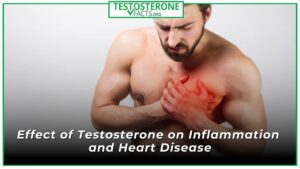
Understanding Testosterone Replacement Therapy: A Beginner’s Guide
- TFacts Staff

It’s natural for men’s testosterone levels to drop as they age, and around 40% of men over the age of 45 have low testosterone, commonly referred to as “low T.”
However, while testosterone is typically associated with libido and fertility, low testosterone levels can cause a wide range of issues that significantly impact your daily life.
If your low testosterone is negatively affecting your health and well-being, your doctor may prescribe testosterone replacement therapy (TRT) to raise and stabilize your hormone levels.
Table of Contents
ToggleSigns of Low Testosterone
Low testosterone is defined as anything below 300 nanograms per deciliter. While most cases of low T are age-related, other factors like weight, high blood pressure, high cholesterol, alcohol and drug use, steroid use, and certain medical conditions can all contribute to low testosterone levels.
Symptoms of low T often include:
- Low libido and/or erectile dysfunction
- Brain fog or difficulty concentrating
- Chronic fatigue
- Mood changes
- Depression
- Difficulty sleeping
- Hair loss
- Enlarged breasts
- Increased body fat
- Loss of muscle mass or difficulty building muscle

Who is a good candidate for TRT?
If you are experiencing any or all of the symptoms listed above, you may qualify for TRT.
Your doctor will start by running blood tests to check your testosterone levels. If they are below 300 nanograms per deciliter, your doctor will likely order further tests to make sure that there are no other underlying conditions that are causing your low T. If nothing is found, they will diagnose you with hypogonadism, which is the medical term for decreased gonad function resulting in low testosterone production. If your symptoms are negatively affecting your life, they will likely prescribe TRT.
There’s no “correct” age to start testosterone therapy, but testosterone levels generally start to decrease in your 30s, with the effects of this drop becoming noticeable around your late 40s to early 50s. However, it varies by individual, and some men need TRT as early as their 20s.
Research has also been done on the effectiveness of TRT for sexual dysfunction in menopausal and postmenopausal women, but it’s not a common nor an FDA-approved treatment method.
Keep in mind, however, not everyone is a good candidate for testosterone replacement therapy. Individuals with sleep apnea or heart problems may not qualify, but your doctor will weigh the benefits and risks for your particular situation and determine if TRT is safe for you.
What is testosterone replacement therapy?
Testosterone replacement therapy is an ongoing treatment to raise testosterone levels to the normal range and keep them there. TRT comes in several different forms, each with their own pros and cons.
TRT treatment methods and frequency
- Intramuscular Injections — given every 2-10 weeks, usually by a doctor, this option is cost-effective, but the effects may wane in between doses. Short-acting injections are given under the skin or in the upper arm, while longer-acting doses are usually injected into the gluteal muscle or thigh.
- Implantable Pellets — provide slow release of testosterone for 4-6 months, but they must be surgically implanted into the upper hip.
- Buccal Tablets — twice daily tablets that dissolve in the mouth, but can cause gum irritation and present the risk of transfer to a partner through saliva.
- Transdermal Patches — applied to the torso, thigh, or upper arm daily, this slow release method mimics the body’s natural hormone fluctuations throughout the day, however, it can cause skin rashes in some individuals.
- Slow Release Gels — applied to the upper arms and shoulders daily, but can be expensive and presents a higher risk of exposure to others.
How long does it take to see results from TRT?
Whichever method you choose, you can expect to start seeing results in a few weeks, with the effects peaking at 4-6 months.
To maximize your results, it’s recommended that you eat a healthy, high-protein diet, along with plenty of fiber and whole fruits and vegetables. However, it’s important to remember that TRT is not a cure, so if you stop treatment, your symptoms will likely return.
What’s the difference between TRT and anabolic steroids?
There are a lot of myths and misconceptions when it comes to testosterone replacement therapy, and many people incorrectly believe that TRT is the same as anabolic steroid use for bodybuilding.
While it’s true that steroid users utilize the same medication frequently used to treat low testosterone, they inject extremely high doses that are incredibly unsafe and can cause severe health issues.
Not only are they abusing the medication and using it illegally, without the supervision of a doctor, they often use it in combination with other substances that are also illegal and/or unregulated.
Testosterone replacement therapy, on the other hand, involves safe doses that are administered under the guidance and supervision of a doctor.
And patients undergoing TRT receive regular testing to prevent unwanted side effects and ensure proper hormone levels.

Benefits of TRT
- Boost libido, treat erectile dysfunction, and improve sexual performance
- Increase bone density, muscle mass, and strength
- Reduce brain fog and fatigue
- Improve mood and well-being and reduce symptoms of depression
However, keep in mind that the symptoms of low T can be caused or worsened by other medical conditions, so not all patients will see dramatic results from TRT. If testosterone replacement therapy doesn’t seem to be working for you, talk to your doctor about the possibility of another underlying condition that may be contributing to your symptoms.
Risks and side effects of testosterone replacement therapy
Can TRT cause prostate cancer?
While it has been suggested that TRT can increase the risk of prostate cancer, recent studies have not shown this to be true. However, your doctor may still be hesitant to prescribe TRT if you are already at a higher risk for prostate cancer, as there is some evidence that TRT can cause existing prostate cancer to grow faster.
How does TRT affect cardiovascular health?
How does TRT affect fertility?

Cost of testosterone replacement therapy
The cost of TRT varies significantly depending on your treatment method, with prices ranging anywhere from $20-1,000 a month for the medication, plus the cost of doctor visits and testing.
If you’re looking for a more cost-effective testosterone booster, there are over-the-counter supplements that can help raise testosterone levels and reduce the symptoms of low T.
However, since supplements are not regulated, you should take some to determine the quality of a product before you use it and only use supplements that have undergone rigorous testing for safety and effectiveness.
To get started, you can check out this in-depth review of the best testosterone boosters.
Is TRT covered by insurance?
Fortunately, testosterone replacement therapy is covered by most insurance providers, so you may only be responsible for your copays. However, your insurance company may require you to use a specific type of treatment. If you choose a different treatment method, you might have to cover the full cost.
To sum it up
Low testosterone can severely affect your quality of life, but for most men, testosterone replacement therapy is a safe, effective way to raise testosterone levels and improve sexual, mental, and physical health and well-being. There are many different treatment options, and your doctor can help you determine which method is right for you and your lifestyle.
However, TRT can be expensive, and there are some potential side effects, including infertility. So if you’re not ready to commit to testosterone replacement therapy, there are also some high-quality testosterone boosting supplements that can help elevate your testosterone level and alleviate your low T symptoms.




